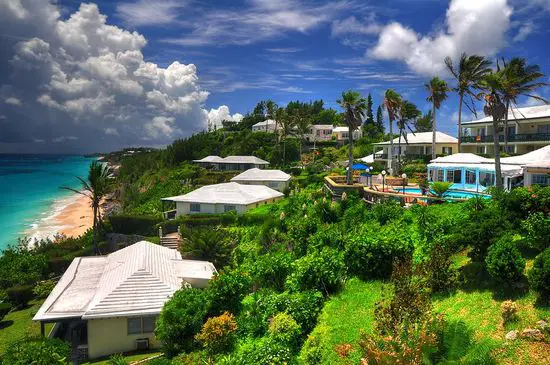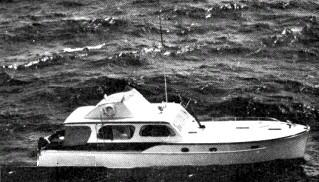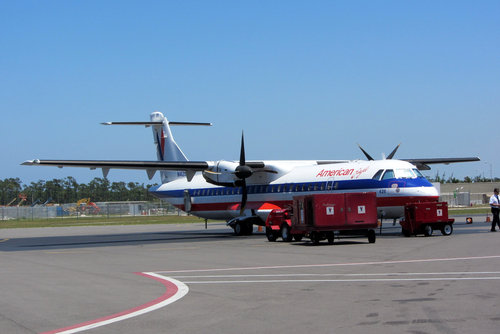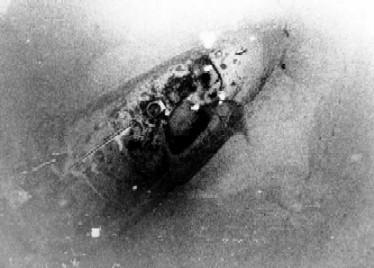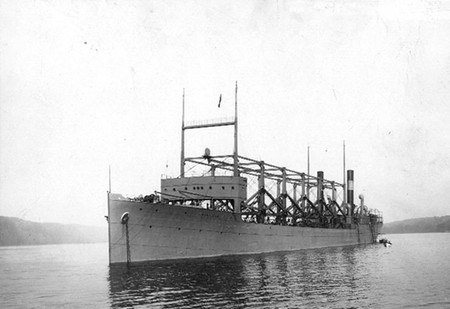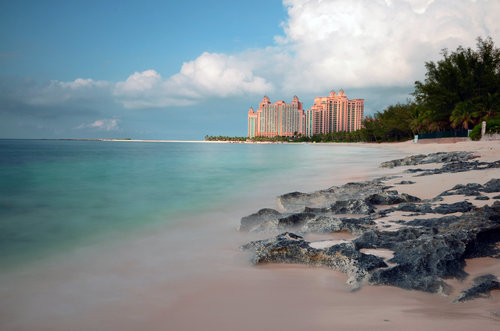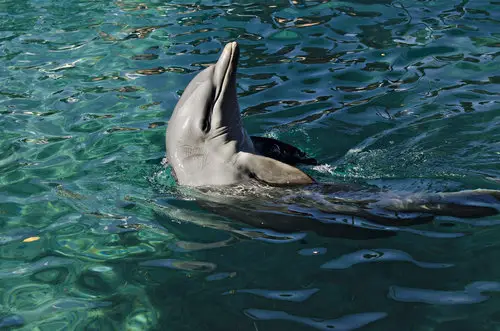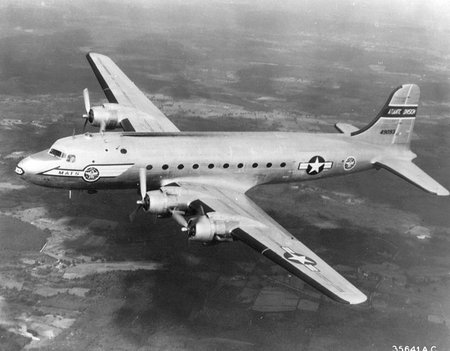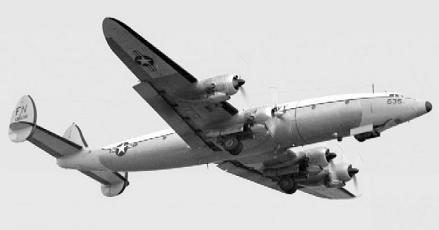This blog contain many fictions, myths, and also facts. It's up to you to choose one or both.
About me

- Agrephino
- Depok, West Java, Indonesia
- My name is Yosafat Jan Diocassa Agrephino. People call me Dio or Yosafat. My birth date is on 8th November 1996. I'm the last child of 4 children. I made this blog just for fun, because i have a lot of free time. One more thing to know, i love peaceful. But if someone got a problem with me, I'll show the real problem
Wednesday, September 21, 2011
Theories About Bermuda Triangle - Methane Gas
It is known that large amounts of Methane gas are trapped thousands of feet below the seafloor.
If this gas gets released, water density in that area can reduce significantly and the frothy water can no longer provide the buoyancy required to keep a ship afloat.
The Methane Gas theory for disappearances of ships and planes in Bermuda Triangle was not much popular until 1998, when Dr. Ben Clennell of Leeds University England, delivered a lecture at Wales.
His main discussion was on Methane gas becoming a big source of future energy. He mentioned that volumes of Methane gas can get released as a result of landslides under the ocean floor.
He went on to state that in such an event, the water density in that area and right up to the surface can get so low that it can make a ship drop like a rock. And since the gas is highly combustible, an eruption can also cause a plane flying above it to catch fire and completely get destroyed.
Here is a similar Methane gas phenomena that I heard directly from a diving veteran of Bermuda at a 2005 conference in Bermuda. This is what he said while talking about ships and planes disappearing in Bermuda Triangle:
Methane gas bubbles are formed on the sea floor and gradually they rise to the surface. These gas bubbles are formed below the ocean floor due to dying and decomposing sea organisms. Initially they are very small in size. As they come up, they keep growing in size.
These gas bubbles become so big at times that they even get larger than size of a ship as they float right below the surface of the water. When a ship passes over it, the bubble bursts. And the vacuum inside the bubble completely engulfs the ship taking it down into the bottom. Even planes flying overhead could catch fire during such a blowout.
Well, there are many counter reasons why such Methane gas theory may not actually justify disappearances in Bermuda triangle. Here are those:
1. The largest chunks of Methane reserves are actually found at a distance away from the Bermuda triangle and not really inside the area where most of the disappearances have taken place.
2. Even if Methane gas is to erupt, it has to cross thousands of feet of sediments below the ocean floor and then more than a thousand feet of water in Bermuda Triangle to reach the surface, and then sink a ship. And it has to rise far beyond to burn an aircraft. This itself is a remote possibility. To imagine that a ship or a plane will exactly be there that time, possibility is miniscule.
3. How does it explain the lost ships or planes in Bahamas where water depth is only about 50 feet or so, and where any sunken ship can easily be found.
4. In some occasions, drilling rigs had unknowingly bored into Methane layer under the sea floor and it has been observed that they actually sank slowly due to less dense water. But it was a slow process and they all had enough time to send out messages a number of times. There was never any casualty. Also, in many cases helicopters circling around the area took close pictures of such incidences. And in no case, any helicopter hovering around the area was ever affected.
Lost Ships In Bermuda Triangle - Witchcraft
Witchcraft was a 23-foot long luxury cabin cruiser owned by Burrack, owner of a hotel. On December 22, 1967 he invited his close friend Father Patrick Horgan to show him the wonderful Christmas time lights along the shoreline of Miami at night.
Their plan was not to go too far. Instead go offshore for about a mile towards buoy #7, stop the engine, and enjoy the lights.
They left the Miami yacht marina in the evening and everything was going well till 9pm when the coast guards received a call from Burrack.
Well, it wasn't an SOS. Burrack's voice was steady and calm. He said that his boat seemed to have hit something, but it was not an emergency. He said his boat needed to be towed. At that time, they were not even a mile offshore.
From the message it was quite obvious that while there might have been some damages in the propeller or the rudder, the hull would have surely been intact. Otherwise Burrack would have called for an emergency. In fact Burrack also mentioned that he had flares with him and would fire one of them to let the coast guards know their exact position.
In about 19 minutes, the coast guards reached the point from where they thought they received the message.
There was no sign of the Witchcraft. Neither did Burrack fire any flares to indicate where he was, nor was his voice heard again.
That night the coast guards continued the search operations covering some 1200 square miles around the spot. No trace of Witchcraft or anyone on board.
Burrack was a veteran and an extremely cautious yachtsman. Apart from the usual life saving equipment like the floating cushions and life jackets, he had fixed a special floatation device in the boat to make it unsinkable. Which means, even if the hull is ruptured and the boat is flooded with water, a part of the hull will still be over the water.
In fact, coast guards do destroy boats with built-in flotation devices that are found half sunk in order to avoid navigational hazards for others. But in this case, nothing was visible. The coast guards even notified the private vessels up to 50 miles away to look out for any debris. They also expanded the search northwards towards the gulf stream. Still no luck.
There was a small thunderstorm on that night for a brief period. So one could imagine whether this squall could have swept the Witchcraft away. That doesn't seem possible either. Burrack would have got enough time to pass on another message or even fire a flare in such a case.
On December 28 after completing a search covering some 24,500 square miles, the coast guards had finally given up. Their final statement said - "They are presumed missing, but not lost at sea".
Lost Ships In Bermuda Triangle - USS Scorpio
USS Scorpion (SSN-589) was a Skipjack-class nuclear powered submarine of the USN (United States Navy).
Scorpion was declared lost on 5 June 1968 and that too while it was not at war.
Scorpion was commissioned on 29 July 1960. After initial assignments of training and other short operations, her home port became Norfolk in 1962 and remained so for rest of her career.
The Scorpion specialized in the development of nuclear submarine warfare tactics. Varying her role from hunter to hunted, she participated in exercises which ranged along the Atlantic coast and in the Bermuda and Puerto Rico operating areas.
In 1966, she was deployed for special operations and entered an inland Russian sea during a "Northern Run" where it successfully filmed a Soviet missile launch through its periscope before being forced flee from Soviet Navy ships by using its high speed.
On completion of such special operations, her commanding officer received the Navy Commendation Medal for outstanding leadership, foresight, and professional skill. Other Scorpion officers and crewmen were cited for meritorious achievement.
Scorpion was a fast attack submarine and had a reputation for excellence.
On 1 February 1967, Scorpion entered the Norfolk Naval Shipyard at her home port for an extended overhaul. In late October, she commenced refresher training and weapons system acceptance tests.
Later on 15 February 1968 she got underway for a Mediterranean deployment. Upon departing the Mediterranean on 16 May, she headed west for home.
On 21 May, she indicated her position to be about 50 miles south of the Azores. Six days later, she was reported overdue at Norfolk.
A search was initiated. But on 5 June, Scorpion and her crew were declared "presumed lost." Her name was struck off from the Navy list on 30 June.
The search continued and a Court of Inquiry was setup by the US navy. At the end of October, the Navy's Ocean research ship Mizar located sections of Scorpion's hull in more than 3000 meters (ie. about 10,000 feet) of water and about 400 miles southwest of the Azores.
Other vessels including the submersible Trieste that were later sent to the wreck area, collected lots of pictures and other information.
The submarine was broken into two major pieces: The forward hull section, including the torpedo room and most of the operations compartment, created one huge trench on impact with the sea floor, while the aft section including the reactor compartment and engine room, created a second impact trench. The sail is detached and lies nearby in a large debris field.
Much of the operations compartment had disappeared, and most of the debris was identified as coming from the operations compartment. One of Scorpion's running lights was locked in the open position as if it had been on the surface at the time of the mishap.
At the time of her sinking, there were 99 crewmen aboard Scorpion. The submarine contained a treasure-trove of highly sophisticated spy gear and spy manuals, two nuclear-tipped torpedoes, and a nuclear propulsion system. The best available evidence indicates that Scorpion sank in the Atlantic Ocean on 22 May 1968
Several theories and explanations have been given as cause of the loss, but none are conclusive. Some have suggested that attack by a Soviet submarine caused Scorpion's loss
The most likely cause was the activation of a torpedo by mistake at the time of inspection. The torpedo, in a fully ready condition and without a propeller guard, then began a live run within the tube. As soon as it got released from the tube, it struck its nearest target, the Scorpion itself. Alternatively, the torpedo may have exploded in the tube due to an uncontrollable fire in the torpedo room.
However, no one till date knows the real cause. The Navy's Court of Inquiry did not reconvene after the 1969 investigation, and did not take testimony from a group of submarine designers, engineers and physicists who spent nearly a year evaluating the data gathered from the wreck of Scorpion.
Lost Ships In Bermuda Triangle - USS Cyclops
USS Cyclops, a huge carrier ship, used to supply fuel to the American fleet during the World War I.
The Cyclops used to displace 12000 tons of water and was 522 foot long.
On 8th of January 1918, the ship started from the snow covered Norfolk navy port towards Rio of Brazil under the command of Lt. Commander Worley. The ship was only few years old. The purpose of this voyage was to unload coal at Rio and load Manganese ores which is used for making steel.
On 28th of January, the ship reached Rio. It would now dock here for two weeks. And as planned, large amount of coal was unloaded and in return, 10,000 tons of Manganese ores were loaded into the ship. So the ship was heavy and almost full.
On the day of its departure, surprisingly, some 73 odd local sailors were also ordered to board the ship. And more surprisingly, the American Consulate General of Rio, Gottschalk also boarded the ship. When asked, he mentioned that he wanted to enlist his name in the U.S army to serve the nation during the war.
USS Cyclops then set sale again on 16th of February with a total of 309 persons on board and huge load of cargo. It was homebound for Baltimore in U.S via Bahi.
Now there was another surprise. After the ship left Bahi, instead of going straight towards Baltimore, the captain took it to Barbados in West Indies on 3rd March. He said that they needed more fuel and supplies. Although the U.S Consul General in Barbados did not feel the necessity of loading more coal and supplies, but the captain insisted and it was finally agreed.
On 4th March, Cyclops set sale again and was scheduled to be reaching Baltimore on 13th March. But, it was never heard of again.
When the ship did not reach Baltimore on the 13th of March, a massive search began along her whole course.
Every naval ship from Cuba to Puerto Rico searched for any possible debris anticipating that it might had fallen pray to German Submarines. However, there was no trace of Cyclops.
Till date, this has remained as the greatest mystery of the ocean, and strangely, the ship was right in the middle of Bermuda Triangle.
So, what happened to USS Cyclops?
There are many theories, but none could prove it with real facts and evidence. Even after some 15,000-page report that the US Navy has produced probing the Cyclops mystery, most of the theories have remained as speculations. Here are some of them:
# The Captain Worley used to be hated by most of his fellow staff and officers. They always accused him to be a pro-German. It was actually found out later that Captain Worley was a German born and had a different name earlier. It is not known what caused him to change his name. Also Gottschalk, the US Consulate General of Rio, who surprisingly boarded the ship along with 73 other local sailors, was also very popular among the German community in Brazil. To top it all, lot more coal and fuel were loaded from Barbados when it was not scheduled for or even required.
So was it a case of Sabotage? Why was there no SOS call made by the captain. Since the US war with Germany already broke out by then, did the captain and Gottschalk connived together and sunk the ship or destroyed it? Or may be taken it all the way to Germany?
# Here is another theory. One of the navy officers, Nervig was onboard the Cyclops till Rio. He wrote a report that he often found the deck of the ship swaying when large waves struck the ship. So the ship was already showing signs of weakening and getting split up. This would have resulted in a major structural failure that sunk the ship.
# Another report says that on its sail from Rio, Cyclops was very heavily loaded with Manganese, fuel and many persons aboard. The load was more than the ship was designed to handle. A heavy mid oceanic storm had hit the ship and it overturned, cargo scattered and it all sank to the bottom of the ocean.
# Was the ship blasted by a German underwater mine or torpedoed by a German Sub? US Navy claims that such possibility does not exist if the ship had been on its right course. However, had the ship been off its track by a large margin, it would have perished.
Lost Ships In Bermuda Triangle - Ellen Austin
The Ellen Austin was an American schooner, a large multi-masted ship weighing over 1800 tons and was 210 feet long.
The ship was manufactured way back in 1854 in Maine. She used to ply between London and New York over the Bermuda Triangle zone in the Atlantic ocean.
In 1881 during one of her London - New York trips, she met with another ship on the way which was moving in good speed. Strangely, the other ship had no one onboard.
In order to salvage this unnamed ship, the captain of the Ellen Austin sent some of his prize crew on board this ship. When the crew boarded the ship, they in fact confirmed that there was not a single soul on board.
The captain of Ellen Austin ordered the crew to guide the ship so that they could all sail together to New York. After two days, the two ships got separated by a huge sea storm. And when the storm subsided, the unnamed ship was gone and never seen again.
Yes, the mystery of the ship is still being explored. The crew and the unknown ship could never be traced again.
However, in 1944, a retired British navy officer, Commander Gould wrote about this incident. In his article, he mentioned that the ship was actually found again by the Ellen Austin, but again like last time, there was no one on board. And the ship was sailing erratically. The crew were also gone.
The captain of Ellen Austin again sent some crew to the ship to salvage it. In few days time, the ship again disappeared and was never traced again.
While the first part of the story is confirmed, the second part could not be confirmed due to lack of proper evidence. Many initially related the case to UFOs and imagined that it could be a case of abduction by the aliens.
The fact is, the mystery is not yet solved to date. Note that Ellen Austin started its journey on December 5, 1880 from London and finally reached New York on February 11, 1881. It was an unusually long journey and indicates that a lot of time was spent in searching for the unnamed ship.
Lost Ships In Bermuda Triangle - Marine Sulphur Queen
SS Marine Sulphur Queen was originally a T2 tanker built in 1944. There were many such tankers built by the US during World War II to carry oil.
However in 1960, this 524-foot tanker was converted into a carrier of molten sulphur.
For that, they had to modify the ship's internal structure and build huge sulphur carrying tanks.
These tanks would always be kept heated up at high temperatures so that the sulphur remained molten.
On February 2nd 1963, Marine Sulphur Queen started her ill fated voyage from Beaumont, Texas destined towards Norfolk. She was carrying over 15000 tons of molten sulphur and 39 crew members on board.
She was last heard on Feb 4th when a routine radio message was received from the ship. There was nothing unusual in the message. However subsequently when all efforts to communicate with the ship failed, a massive search operation was launched. After 19 days of sea combing operation, the rescue team found only some debris and life preservatives. There was no trace of the ship or its crewmen. The ship had simply disappeared somewhere in the south Florida Straits.
-Investigation of Marine Sulphur Queen mystery
US Coast Guard launched an investigation into the mystery of Suplhur Queen. It was true that at the time of her disappearance, the sea was rough and the waves were some 16-foot high. But can that really make such a huge ship disintegrate altogether?
Here are some of the important investigation findings of US Coast Guards:
# The ship was often seen with fire around the Sulphur tanks. This was caused due to leakage and heat around the tanks. This was so common that often the crew did not even bother about it. In one occasion, the ship even came to a New Jersey port with such burning fire, offloaded sulphur and sailed out while there was still fire around the tanks.
# Due to heavy corrosion, the keel (a structure) in the middle portion of the ship was becoming very week. It was quite possible that the keel could split up. The ship was actually due for its routine maintenance in January before its sail. But the owners insisted that ship required to sail as it was behind its schedule of cargo deliveries. In fact, before the ship started its last sail, a crewman was heard telling his wife ... the ship was a "floating garbage can".
-Conclusion
Well, as extensive search resulted into nothing but only some debris and such, the Coast Guards and the Navy Board reached the conclusion that the ship was actually lost in the sea. They also concluded that it was lost on February 4, 1963 near the Straits of Florida.
While they could not assign any definite cause to the loss, they highlighted that the following could have been the possibilities:
# An explosion could have taken place in the cargo tanks due to leakage.
# The vessel's hull may have split up into two.
# The ship may have been capsized in rough sea.
# A steam explosion may have happened and the crew would have got poisoned.
Lost Ships In Bermuda Triangle - Mary Celeste
On December 4, 1972 Mary Celeste, also known as the Ghost Ship, was found without a single soul on board while she was still sailing. She was located off the coast of Portugal heading towards the Strait of Gibraltar. This happened even though the weather was fine and she had very experienced and able crew. Here is the full story:
The Mary Celeste was Originally named "The Amazon", when it was built at the shipyards in Spencer Island in Nova Scotia, Canada in 1861.
It was launched in 1961 which also happened to be the year when the American Civil War broke out.
The brigantine Mary Celeste was 31 meters long, 7.6 meters wide and displaced 282 tons of water. However since her launch, she had always been influenced under some evil power.
During her first decade of operations, she was involved in several misadventures and passed through many changes of ownership. It was as if the ship was under the influence of a bad evil.
Look at the following chronological events:
# The First master Robert McLellan fell ill and died.
# On her maiden voyage commanded by John Parker, the ship suffered a big damage in her hull after running into a fishing dam off the sea. Mary Celeste required major repairs at the shipyards. Later, a fire broke out at the shipyards, terminating Parker’s command.
# During her first Atlantic crossing, she collided in the straits of Dover with a two-masted ship which sank. Mary Celeste again required repairs.
# Upon her return to America she ran aground off Cow Bay, Nova Scotia.
# After she was pulled out of the rocks, she continued to change hands between a number of owners. No one made any profit. In fact, some of them went bankrupt.
# Finally she was purchased by an American, James Winchester. James bought her at a New York salvage auction for $3,000. She went through extensive repairs and renovation. When she was back again, the ship looked completely different and hardly had any resemblance with 'The Amazon'. Her name was then changed to Mary Celeste.
In October 1872, Mary Celeste was made ready on a birth in New York's East River for a voyage to Genoa, Italy.
The captain of the ship was Benjamin Briggs aged 37. Briggs’ 30-year old wife Sarah and 2-year-old child were also in the ship. And there were 7 crew making it a total of 10 on board.
Captain Briggs was a very experienced and able seaman and captained five ships in his career. He himself was an owner of many ships and had spent most of his life on the sea.
Mary Celeste departed New York City on November 7, 1872. She was carrying a cargo of 1701 barrels of raw commercial alcohol valued at some $35,000 and had full insurance.
Strangely after almost a month of her sail, on December 4, 1872 a British Empire vessel named Dei Gratia found the Mary Celeste off the coast of Portugal. She apparently looked abandoned although still under sail. There was not a single soul on board.
So what could have been the cause of such mysterious abandonment? The weather was fine and she had 6 months of food and water. The crew were all very able seamen and trustworthy. Even the personal belongings including valuables were untouched.
Here are some speculations and theories behind the mystery of Mary Celeste:
-Piracy
Some speculated that the Mary Celeste had fallen pray to the North African pirates who were known to be operating in that area. The pirates would have killed all on board and threw the bodies over to the sea.
However, there was no such incidence of piracy reported in the Straits of Gibraltar for the last one decade. This is possibly because the British Navy were stationed there.
Even if there was piracy, it is almost impossible to believe that the pirates would spare all personal and valuable possessions of the crew members.
They did not even touch the cargo. Also there was no sign of violence on the ship.
-The Dei Gratia crew as suspects
Another theory was that the crew of the ship Dei Gratia that salvaged the abandoned Mary Celeste, would have murdered all on board and then fabricated the story of Ghost Ship in order to claim the salvage rights.
But this seems very unlikely. There was no sign of any struggle on Mary Celeste. Secondly, Dei Gratia departed one week after Mary Celeste did and could not have caught up with it. Also Morehouse, the captain of Dei Gratia was a good friend of Briggs.
-Insurance Scam
Some thought that the whole incidence was probably to make a fake insurance claim. But that would have required Morehouse of Dei Gratia to connive with Briggs to make it happen. While this was possible, the ship Mary Celeste did not belong to either of them. The owner was James Winchester.
Also, the insurance value was quite modest. So such a planned and staged act for such a modest amount looks quite improbable.
-Storm
It's true that when the crew of Dei Gratia salvaged the Mary Celeste, they found a lot of water in between the decks and about 3 and half feet water in the hold. Also, two out of the three water pumps were found to be disassembled while only one was working. This led to the theory that Mary Celeste would have been hit by a severe storm and while it was sinking, captain Briggs ordered the crew to evacuate.
But there are fallacies to this theory as well. There was no such storm reported in that area of Atlantic during the time the Mary Celeste was discovered abandoned. Also, the water level was not enough for a captain to order evacuation. The ship was still in sail worthy condition. However, it is possible that since Brigg's own family was on board, he would have been extra cautious. Then why didn't they all return and explain the story to all?
-Drunken Crew
It was found that 9 out of the 1701 barrels of alcohol were empty. So there was a speculation that the crew members would have consumed all the alcohol, got drunk and murdered the captain and his family due to Brigg's tyranny over the years.
Sounds good, but seems unlikely. Briggs was known as an able and well behaved captain. Also, he was never heard consuming alcohol himself and therefore likely not to have allowed crew members to consume alcohol on board.
-Seaquake
A modern Captain David Williams offered an explanation stating that there was earthquake under the sea. As a result the nine barrels would have got dislodged and the alcohol would have leaked. So that explains the empty barrels. Heavy rumbling of the sea made the crew members panic and they jumped into a small sailing dinghy boat. Later they tried to catch up with Mary Celeste but could not, and died on the sea.
Well, this sounds interesting too. But the fact is, the crew of Dei Gratia did not report any sign of rumbling or aftershock. Also, there was no quake reported at the nearby Portuguese islands or Azores during that time.
-Explosion
Out of all the theories, a possible explosion causing Mary Celeste's abandonment seems to be the one most likely, although it too has its own caveat. This theory was offered by James Winchester, the owner of Mary Celeste himself.
The nine barrels of alcohol which were found empty, were made of red oak and not white oak as the others. Red oaks are generally more porous. There may have been slow alcohol leakage thorough those. That would have create alcohol vapor in the hold. The barrels, that were tied with steel bands would have rubbed against each other. The friction in the steel bands then created a spark which would have then caused an explosion.
Captain Briggs seeing a violent gush of fumes and fire, would have panicked and ordered the crew to immediately get on to the life boats. In hurry, the crew could not possibly tie their boat to the ship with a strong rope. And subsequently, a strong wind would have swayed them off and all would have drowned, or died out of hunger or exposure to weather.
However, the caveat to this theory is that when Mary Celeste was salvaged, no one could get smell of the alcohol fumes outside the hold, nor could they see any burn marks. Who knows whether the nine barrels were actually loaded empty at New York itself!
There is no explanation that substantiates the Mary Celeste abandonment with full evidence and facts. So this remains as one of the greatest mysteries of the ocean.
By the way, this incidence of Mary Celeste is sometimes confused with another ship that had the same name and actually sank off the coast of Bermuda in September 1864.
Lost Planes In Bermuda Triangle - C-54
Many of the researchers and authors discounted the incident of C-54 as another case of the thunderstorm accident.
Yes, its true that the C54, that took off from Bermuda on July 3, 1947 met with a huge squall - a massive thunderstorm.
And that would have surely caused the disintegration of the aircraft as reported by the investigation Board at Florida. But the real question is, why did the C54 get into the eye of the storm when it could have easily avoided it.
So let's go through the sequence of events. C54 was a military version of the aircraft Douglas DC4 and was capable of carrying 85 passengers. On the day of the flight, there were five crew members and the experienced pilot major Ward.
The report from the investigation board shows that the squall was actually not at all in the originally scheduled route of the flight. Right from the start, the flight started going off course, and apparently neither the pilot nor the navigator on board were aware of this.
Soon after it took off from Bermuda, it was far south of it's scheduled course. And then after a while, it suddenly made a course change and moved towards north and then south west. As a result, now it was heading straight towards the eye of the storm.
It continued to fly in the same direction for a fairly long time till the ground radio operator heard a faint garbled SOS. The sound was so low that he ignored that to be a real SOS. Then the faint garbled sound was heard once again and then it was all silent.
The investigation board at Morrison Field, Florida went on to investigate why such odd change of course was done. They checked the credential of the navigator on board.
He was a last minute substitute but a class-II navigator, which means he was qualified for the job.
Major Ward was in charge. It is still unexplained how both of them could have made such a blatant mistake and had forgotten all their training to avoid a squall.
Only about a month before, a general instruction was given to all the pilots to avoid thunderstorms, yet Ward flew the plane right into it and the navigator guided him to do so.
About 209 miles north east of Florida, the debris were finally found. It consisted of oxygen bottle and some equipment, all of which reflected a case of a sudden destruction.
Here is the final report from the investigating board:
"After considering all available facts and existing weather conditions, it is the opinion of the Accident Investigating Board at Morrison Field, Florida, that the aircraft encountered violent turbulence and the pilot lost control of the aircraft. It is possible that structural failure was a factor prior to contact with the ocean. No evidence of fire exists.
There was no evidence of a ditching attempt and the debris found indicates that the crew compartment was torn apart on contact with the ocean. The last plotted position of the aircraft and the corresponding position of the frontal zone substantiates the weather assumption. Contributing factors to this accident were possible navigational error allowing aircraft to drift north of course to frontal zone and pilot error in that no apparent effort was made to circumnavigate the frontal weather."
Lost Planes In Bermuda Triangle - Flight 441
Flight 441 was a huge carrier that belonged to the US Navy. The civilian or the commercial model of the aircraft is known as the Super Constellation. In military version, it was called R7V-1.
The aircraft was one of the greatest success of its time. It was touted that it could cross the Atlantic in 8 and half hours.
On October 30, 1954, the flight 441 took off from the Patuxent River Naval Air Station bound for Lajes in Azores.
It was carrying 42 passengers - all naval officers and their families who were transported overseas.
Like in many of the Bermuda Triangle incidences, initially there were regular communication received from the aircraft. And suddenly, it was all silent. The last transmission was received around 11:30p.m which was a regular report informing its location. That time the aircraft was about 400 miles off the coast.
And after that, Flight 441 simply vanished. The disappearance of Flight 441 remains as one of the biggest mysteries of Bermuda Triangle. Not even a single clue till date has been gathered to throw any light on the cause.
The incidence was thoroughly investigated by the board, which focussed on the plane itself, the weather and the Pilot Leonard's capability.
The weather was somewhat typical for the North Atlantic at this time of the year - no snowing, sporadic thunderstorms and mild turbulence. But the flight 441, capable of attaining great altitudes, could have easily been above this weather.
Plus the aircraft had a weather radar installed on it which was capable of giving forewarning if there was any adverse weather condition detected. The experienced pilot certainly would have avoided the bad weather based on the indications from this weather radar.
Here is what the board of investigation reported about the Pilot and the weather:
. . .Lt Leonard has been flying the North Atlantic routes for the past two years and it is thought that he was very familiar with this kind of weather. His choice of 17,000 feet altitude for this flight was a good one. According to the weather cross section 19,000 feet would have been an even better altitude. At any rate he should have been on top, for the most part, except for occasional buildup. It must be pointed out that the R7V-1 was equipped with ASP-42 Airborne Radar and is always used when flying this sort of weather.
The Board also reported: “The possibility of structural failure during transit of frontal weather cannot be discounted in this accident, but the possibility appears remote.”
On Pilot's capability, the Board commented:
Lt. Leonard was well trained in thunderstorm penetration speed and technique. It is thought that if he did enter a thunderstorm he would have entered at the correct speed and would have flown the up and down drafts without fighting them. The weather that Lt. Leonard was thought to have been subjected to was not beyond the capabilities of R7V-1, nor was it thought to be beyond his own capabilities.
So what could have happened to the Flight 441?
Let's take a look at the list of cargo carried by the aircraft: 111 life vests, 46 exposure suits, 660 paper cups and 5 life rafts. All these can easily float in water. So, if the plane blew off in the air, all these would have got scattered on the ocean water and could have been traceable. If she simply nose dived into the water without breaking off, the pilot should have sent an SOS. But none, apparently seem to have happened.
Here is what the board had to say finally:
It is the opinion of the Board that R7V-1 BuNo 128441 did meet with a sudden and violent force, that rendered the aircraft no longer airworthy, and was thereby beyond the scope of human endeavor to control. The force that rendered the aircraft uncontrollable is unknown.
Well, I thought it was a classic statement and can probably explain all cases of Bermuda Triangle disappearance in just couple of lines
Subscribe to:
Posts (Atom)

